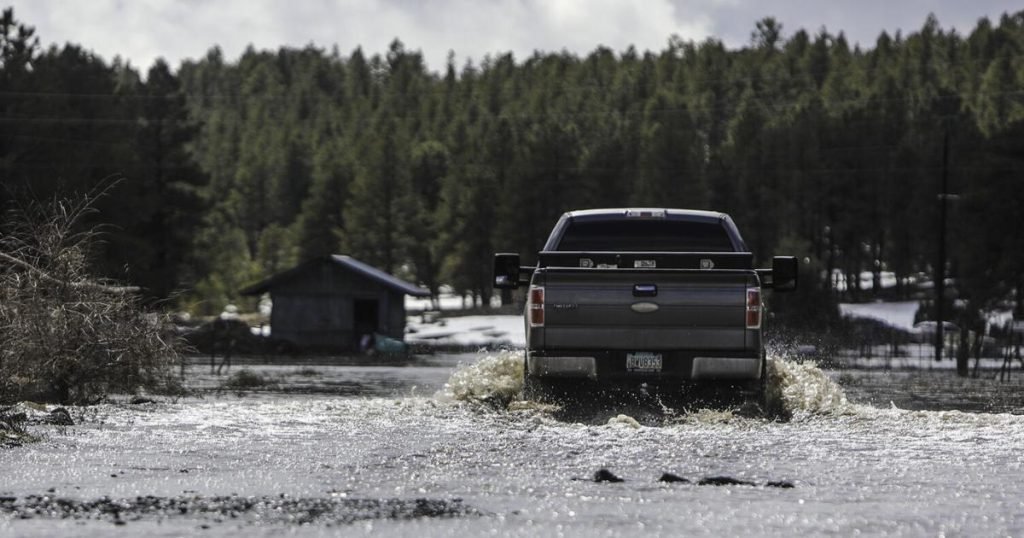DAN McEVOY Desert Research Institute
After three years of extreme drought, the western United States is finally taking a break. The mountains are covered in deep snow, filling many local reservoirs, followed by a series of atmospheric rivers that have brought record rains and snow to much of the region.
Many are looking at the snow and water levels and asking, “Is the drought finally over?”
The answer has many nuances. Where you are in the West and how you define “drought” makes a difference. As a drought and water researcher at the Western Regional Climate Center at the Desert Research Institute, here’s what I see.
Each region has a different recovery speed
The winter of 2023 could have a significant impact on drought improvement, easing the water scarcity problem of the past few summers.
People are also reading…
I say “potentially” because in many regions, much of the impact of drought tends to show up in the summer. When the winter rains and snow stop and the West begins to rely on reservoirs and streams for water. Spring heatwaves, such as we saw in 2021, and rains in the mountains can cause the snowpack to melt faster than usual.
California and the Great Basin
In California, atmospheric rivers that caused massive flooding in December and January have all but eliminated the state’s three-year rainfall deficit. By early March, snow cover across the Sierra Nevada was well above its historical average, with some areas exceeding 200% of his average. Southern California’s Metropolitan Water District announced on March 15 that it will end emergency water restrictions for about 7 million people.
In California and the Great Basin, which straddles Nevada and western Utah, most surface water droughts (droughts involving streams and reservoirs) could be cleared by summer.
But it’s only surface water. Drought will also affect groundwater, and it will take longer for the impact to ease.
A study in California found that even after wet years like 2017 and 2019, groundwater systems have not fully recovered from previous droughts. This is partly due to years of overpumping groundwater for agriculture and partly because the aquifer was not fully recharged.
In that sense, the drought is not over. However, on the broader scale of the region, many of the effects of drought that people will experience will be reduced or nearly eliminated by this summer.
Colorado River Basin
Similar to the Sierra Nevada, the upper Colorado River basin (Wyoming, Colorado, Utah, and northwestern New Mexico) looks to have a healthy amount of snow and a lot of water this year.
But one good water year never fills Lake Mead and Lake Powell. Most of the region depends on these two her reservoirs, which have declined to alarming levels over the past two decades. NOAA’s seasonal drought outlook, released March 16, showed both to remain low.
Two good water years don’t do that either. Over the next decade, most years will need to be above average for these giant reservoirs to fill. Rising temperatures and dryness make it even more difficult.
So that system will continue to deal with the same long-term drought effects we’ve seen. Reservoirs may rise somewhat, but they are far from capacity.
Pacific Northwest
The Pacific Northwest is a little drier with less rain and less snow. But it’s close to average, so it’s not a big concern, at least for now.
Forests, Rangelands, and Fire Risk
Droughts can also have long-term effects on the health of ecosystems, especially forests.
The Sierra Nevada has seen extensive tree death associated with recent droughts, including northern areas around Lake Tahoe and Reno, which were unaffected by previous droughts. Whether recent extinctions are due to the severity of current droughts or the lingering effects of past droughts is an open question.
Even with the wet winters, it’s not clear when the forest will recover.
Since the pasture is mostly grass, it recovers in a few months. Soil moisture is very high in many of these areas, so range conditions should be good throughout the West, at least into summer.
However, if the West continues to experience another very hot and dry summer, drought could increase again, especially in the Northwest and California. And communities need to think about fire risks.
A lot of soil moisture and snow cover are currently making the chances of large fires in the southwest less than normal in early spring.
Higher mountains and forests are likely to experience longer-than-average snow cover than in recent years, so the fire season could start later in those areas. However, in low-lying areas such as Great Basin shrub and grassland-dominated ecosystems, fire hazards can begin early in the year when the land dries out.
Long-term outlook is not always reliable
Many atmospheric measurements make it look like California is coming out of the drought, and it feels like the drought is ending elsewhere. But it’s hard to say exactly when the drought will end. Studies show that the hydroclimate in the west is more variable, changing from drought to deluge.
Droughts are also difficult to predict, especially over the long term. Researchers can get a good idea of what’s going on a month ahead, but the chaotic nature of the atmosphere and weather makes long-term forecasts less reliable.
We saw it this year. Initial forecasts were that the winter of 2023 would be dry across much of the west. But in California, Arizona and New Mexico the opposite happened.
Seasonal forecasts tend to be highly dependent on El Niño or La Niña years, and sea surface temperatures in the tropical Pacific can affect jet streams and atmospheric conditions around the world. During La Niña, the pattern seen from 2020 to March 2023, the Southwest tends to be drier and the Pacific Northwest to be wetter.
But that pattern doesn’t always set in exactly the same way and in the same place, as we’ve seen this year.
There’s a lot more going on in the atmosphere and oceans on short-term scales that could dominate La Niña patterns, including this year’s series of atmospheric rivers.
This article is republished from The Conversation under a Creative Commons license. The Conversation is an independent, non-commercial source of news, analysis and commentary from academic experts.
be the first to know
Get local news delivered to your inbox.







